|
Monday, December 6, 2010
Progress Notes
I have featured board member Jim Clark several times on the website regarding his skilled carpentry and other talents helping us with various projects at the museum. Here is a photo of Jim in front of the Tuscumbia Presbyterian Church Bell for which Jim built the outside display stand (photo 01):
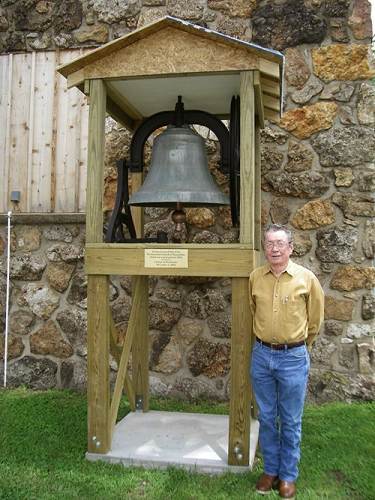
01 Jim Clark in front of Bell Another time I featured the story of the work Jim and his father, Arthur Clark, performed in restoring the old George Nichols home in Tuscumbia which you can read about at this previous Progress Notes.
Here is a photo of the rehabilitated home (photo 02):
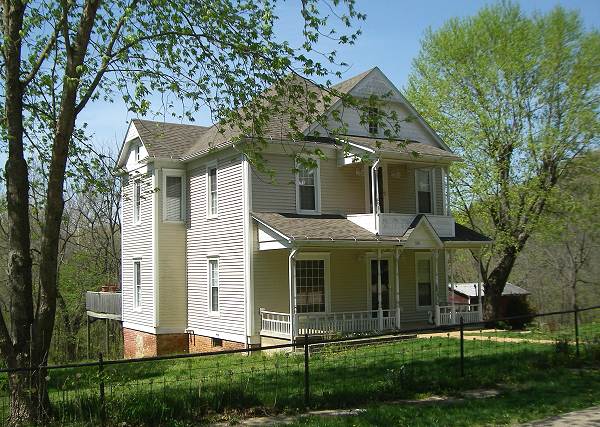
02 George Nichols Home But undoubtedly, Jim inherited his multitalented carpentry and all around construction skills from his father, Arthur Clark (photo 03).
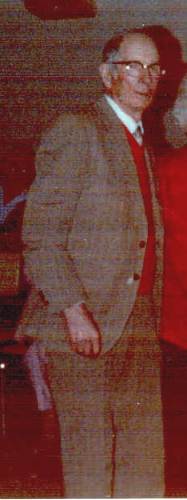
03 Arthur Clark Arthur’s life history is one that goes back to the steamboat days when he spent quite a lot of time on the Osage River. He helped build Bagnell Dam and was part of the group which did the survey work for the dam before construction as well as other tasks he performed at the dam in later years. He was familiar with all the hard work that our early forefathers did years ago. For example, at the Bicentennial Celebration in 1976, Arthur won the tie whacking contest at the age of 69 years of age (photos 04 and 05)!
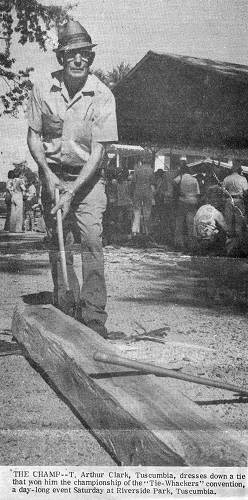
04 Arthur Clark Whacking Tie
Click image for larger view
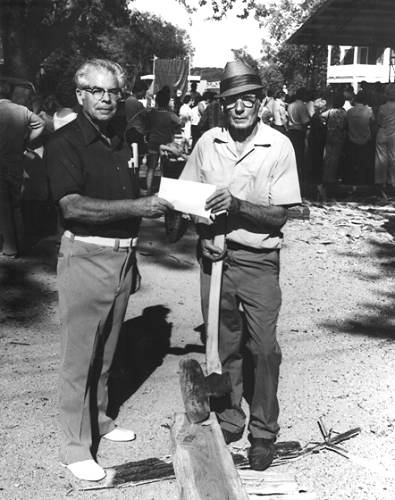
05 Arthur Clark receiving award from Earl Brown We are very fortunate that long time Vernon Publishing Company reporter and journalist, Ginnie Duffield, has taken the time during the years to interview and publish the stories of our county history and the people who were our antecedents here. Twelve years ago Ginnie interviewed Arthur Clark and published his story for all of us to know about his skills and very interesting personal history:
Life’s Work On River Spans Steamboats To Dams For Tuscumbia’s Arthur Clark
Some of His Work Helped End River Trade Era in Miller County
Story and Photos by Ginny Duffield
Miller County Autogram Sentinel March 12, 1998
Since his childhood, Tuscumbia resident Arthur Clark, 90, has seen the Osage River go from a busy thoroughfare for steamboats, to a stream controlled by hydropower. He has worked on steamboats, even holding a pilot’s license, but he has also worked on Bagnell Dam, the structure that ended riverboat travel nearly 70 years ago (photo 06).
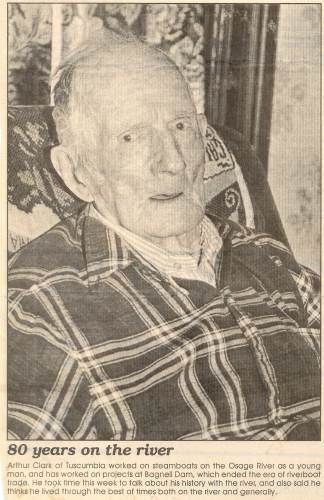
06 Arthur Clark
Click image for larger viewClark said he was working on a riverboat, the Hayes, in the late 1920’s when the river got low and the boat could not run. He joined a survey party for a Kansas City company that originally planned to build a dam on the Osage, just upstream from Bagnell. He remembers he worked for $15 a week plus his board. The crews camped in tents as they surveyed the area where the proposed lake was to be impounded.
“We didn’t work but just a short time,” Clark said. The river came back up and he returned to the riverboat. The Kansas City company had to give up the idea of the dam but eventually Union Electric built it.
Before the dam was built, about 80 percent of the freight coming in and out of Tuscumbia came or went by boat, Clark, said.
Locally, the Anchor Milling Company and the boats associated with it are well known. Clark, though, worked for an Osage City company. Jim Hayes purchased wheat in the area at a price within a $1 of what they were paying in St. Louis. He milled it into flour and sold it all over this part of Missouri, Clark said, becoming a millionaire in the process. The Hayes mansion still stands at Osage City, Clark said, where the mill was located.
In 1929, Clark remembers he stayed in the cabin of the boat the Richard Rose while it was tied up under the Missouri Pacific railroad bridge at Osage City. “I watched the fleet there,” he said. Two other companies had their boats tied up for the winter too, he said.
The landing at Tuscumbia was about where the Conservation Department’s boat ramp is located now, Clark said.
“I’ve come right up against that bank,” Clark said about landing boats at Tuscumbia. “I’ve been as far as Osceola in a steamboat.”
He also has been on boats that worked on the Missouri River.
Clark still has the names of the shoals, or shallow places, on the Osage memorized, at least, below Bagnell Dam. He ticks them off in order: Bagnell, Williams, Bailey, Sim Brockman, Brockman, Bed Quilt, Lick Creek, Gum Creek, Tuscumbia, Cedar Bluff, Saline, Dog Creek, Coon creek, Musick, Berry, Capps (also known as Pock), Devil’s Elbow, Curtman, Tappehorn, Reynolds (just above Tavern Creek), Hoskins, Thornton’s, Morris, Sugar Creek, Schuyler’s Ferry, Wood Island, Bois Brule, and a number more before the Osage runs into the Missouri at Osage City.
There was a lock and dam at St. Thomas, which is still in the river but unused. Clark has made many trips through it, waiting for the lock to either raise the boat over the shoal or let it down on the downstream side.
For a time, Clark also cut oak logs and floated them down the Osage River and the Missouri, to Gasconade where they were sold.
When damming of the Osage ended the local steamboat business, Clark took up carpentry, and followed that trade until he retired about 1980. He said he couldn’t count the number of houses and other buildings he has built or worked on in the area, including much of the North Shore of Lake of the Ozarks.
In 1936, Clark worked with a crew that cemented rocks along the river bank just below the dam. The railroad tracks that had been laid to haul in construction supplies to the dam when it was built were still there. Clark said the workers stayed on site, housed in railroad cars.
“It was back breaking work, stooping over that bank,” Clark said. Rocks, sometimes weighing 300 to 400 pounds, had to be wrestled to where they were needed and placed so they would not slide down the bank before the cement set enough to hold them.
When the big Osage River flood of 1943 caused water to enter the interior of Bagnell Dam, Clark was one of the men hired to clean up the mess after the flood receded.
“It floated logs and drift in there,” Clark said. The place was also full of catfish. Clark said the logs had to be pulled out and “put over the wall.” Workers pulled out sacks of catfish to take home as the water was pumped out of the dam. Sometimes another worker would steal the sack of fish before it was time to go home, he said.
“There was probably a truck load of catfish in there,” he said.
Then, in the early 1950’s, Union Electric decided to have two more generators installed. Clark, who was a union worker, was in on that job too. It took two years to do the work.
When concrete pours were done, the workers stayed until it was completed. One started at 6 a.m. one day and did not stop until 3 a.m. the next, he said. One pour was 713 yards of concrete, Clark said. “They never stopped until they got it done.
“There’s no place in that dam I haven’t been,” Clark said.
Clark actually had an employee relationship with Union Electric until recently. For many years, he took the river readings at Tuscumbia for the utility, earning a monthly paycheck. However, the company, now AmerenUE, no longer keeps track of the daily river levels at Tuscumbia, Clark said.
Last fall, he met with company officials who were making a video of the history of Bagnell Dam. Clark hopes to get a copy of that tape.
Clark also has been involved with other large construction projects, either as a worker or contractor.
For a year when he was a boy, his family lived in Jefferson City. The old Missouri Capital building had burned and a new one was being built. Clark got a job cleaning out the bore holes for pilings that go all the way to bedrock. He said he worked as far as 50 feet under ground, putting rubble in a bucket so it could be hauled to the surface.
He also remembers the steel skeleton of the building rising over the Missouri River. During World War I, construction had to be halted because of a wartime shortage of steel, he said.
Many is the time Clark either walked over or rode over the old wooden suspension bridge at Tuscumbia in 1905. He said it cost a nickel to walk over the toll bridge. A car or truck carrying just two people could cross for 50 cents. But if there were more than two people aboard, there was a nickel charge for each extra person, Clark said. The bridge owners were understandably against the state building a new bridge across the river.
Clark can remember the coffer dam pieces being driven to provide a dry area for the center pier to be built for the new bridge replacing the suspension bridge.
He also remembers the 1933 bridge opening. The old suspension bridge owners may not have been happy, but at least 1000 area residents, and perhaps as many as 1,500 area residents, came to the grand opening in the early 1930’s of the bridge they could now cross for free, Clark said.
In about 1970, Clark and his wife Millie sold the old home place to one of their daughters and son in law. They had purchased an old house in Tuscumbia, and had intended to fix it up and sell it. They ended up living in it (this was the old George Nichols home - see photo 02 above) (photo 07).
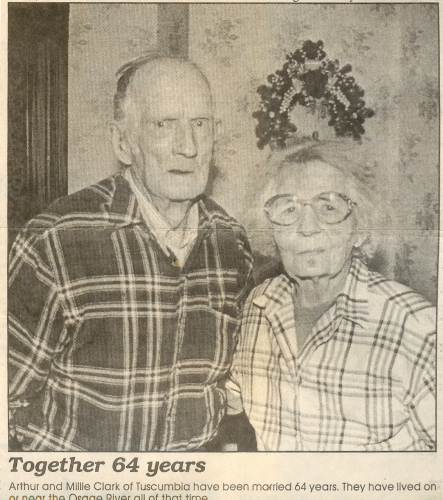
07 Arthur and Millie Clark
Click image for larger viewThere were only three light bulbs in the old house, so son Jim rewired the house. The old plaster walls were so fragile they could not be patched, so down they came and up went plasterboard. Original woodwork and door knobs were left in place, though, leaving the home’s Victorian character intact.
Clark said his son Jim, who is postmaster at Tuscumbia, is one of the best carpenters he has ever worked with. Only one other man he has worked with had as much skill, Clark said. He and his wife credit Jim with making the old house, built in 1900, a comfortable home for them.
Clark heats the old house with wood and still cuts it himself. He also likes to go down to the river landing every day possible. A broken hip last year slowed him down for a while, but he is getting around fine now as long as he doesn’t get overbalanced, Clark said.
Clark and his wife, married 64 years, have five children: Jim, Orville, Linda, Glenda and Colleen. Linda and Glenda are twins. All but one live in this area.
Clark said he would like to see the Osage dredged out again. He can remember when the U.S. Army corps of Engineers dredged it every year. When it is low now, even a jon boat can get stuck in the shoals, Clark said.
He also enjoys watching large barge tows on the Missouri River whenever he gets the chance, and thinks shipping by barge is the best way for many products, such as fertilizer.
“For eighty years, I’ve lived on this river,” Clark said.
He would like to live on it for many more. Sometimes on television he hears a half dozen 100th birthdays announced in one day.
As a young man, “I never knew of even hearing of but one man that lived to be 100 in Miller County,” he said. He thinks he has a shot at making the century mark himself.
Thanks for the great article, Ginnie!
Unfortunately, Arthur didn’t make the 100th year birthday. He was born in 1907 and passed away in 2000 at the age of 93.
Arthur Clark is one of many Clarks of Miller County who can trace themselves back to the original Clark of their line, John ‘Hoppin’ Clark, a man of quite colorful history. We have a photo of Arthur’s father, Thomas Logan Clark (photo 08); but no photo exists I could find of his grandfather, James Prior Clark, or his famous great grandfather, John ‘Hoppin’ Clark.
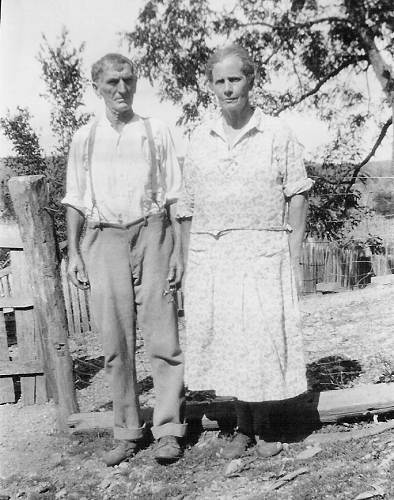
08 Thomas Logan Clark and Della Bell Roark Peggy Hake has written a short anecdote about John ‘Hoppin’ Clark which is on our website.
For convenience I will copy that article here:
John ‘Hoppin’ Clark
By Peggy Hake
There has been a beautiful legend handed down through the generations about John 'Hoppin" Clark. He acquired this nickname through the impossible feat of jumping over covered wagons! He was a loner for a few years preferring to travel the wilds of Kentucky's back country. One night he ventured upon a wagon train traveling westward and they hired him to serve as the scout. On this wagon train was an Indian family with the English name of Farmer who had a beautiful young daughter named Snow Princess. Her English name was Elizabeth and John Hoppin' fell in love with this beautiful Indian maiden. He asked her father for his consent to marry her, but he refused, so John kidnapped Snow Princess and they were eventually married without her father's blessing. John Hoppin' & Elizabeth Clark moved into Miller Co. and settled near his sister and family who had bought land in Osage township.
As a child, I was told many stories about this colorful couple, but my favorite has to be this bit of legend: One day old Hoppin' went out squirrel hunting and was gone all day. By nightfall, Betsy (Elizabeth) was getting a little worried. After dark he finally came home but was a terrible mess---he was scratched, torn, and bleeding all over. He was dragging a big, black panther and as he threw it into the kitchen door, he said these infamous words... “Here Betsy, skin this squirrel!!”
It is also family legend that John Hoppin' Clark served as a scout for the Cherokee Indian Nation when they were forced from their homes in the Smokey Mountains of North Carolina & eastern Tennessee. This was the “Trail of Tears” march to Oklahoma territory in the late 1830s.
Thanks Peggy.
The Clark family is one of Miller County’s largest regarding the number of progeny who resided here through the years. Nancy Thompson, museum director, has provided us with two genealogical studies of the family. The first one contains quite a few historical anecdotes and obituaries which you may find interesting (photo 09).
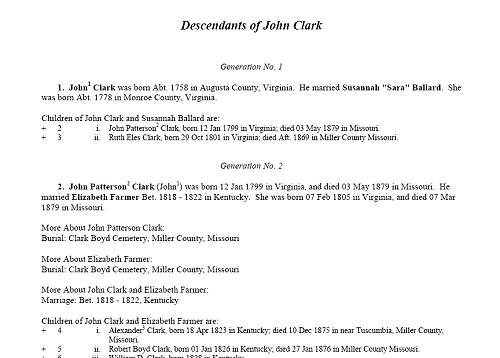
09 John Patterson Clark Genealogy 1
Click image to view entire document in PDF formatNancy’s second genealogical study is more strictly in outline form which is designed for quick location of a particular name in which one may be interested (photo 10).
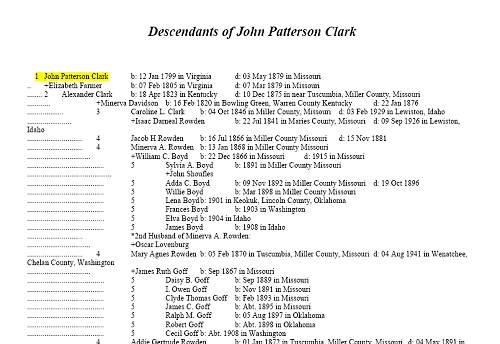
10 John Patterson Clark Genealogy 2
Click image to view entire document in PDF formatWe are very fortunate that Miller County native Brenda Ewan (photo 11), who is a direct descendent herself of John ‘Hoppin’ Clark, has collected many photos of the Clark family.
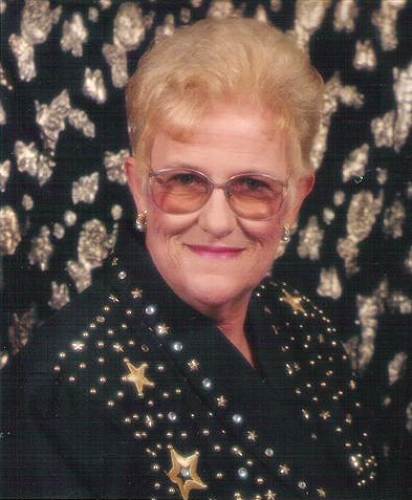
11 Brenda Boyd Ewan Here is Brenda’s lineage back to John ‘Hoppin’ Clark:
John “Hoppin” Clark
James Prior Clark
Thomas Logan Clark
Bessie Bell Clark, married John Wickham
Thelma Wickham, married Belvia Boyd
Brenda Boyd Ewan
And here is Jim and Arthur Clark’s lineage going back to John ‘Hoppin’ Clark:
John “Hoppin” Clark
James Prior Clark
Thomas Logan Clark
Arthur Clark
Jim Clark
Brenda kindly has loaned her photo collection to us for scanning. I think the easiest way to present these photos is in alphabetical order as a collage. In that manner if you are looking for a particular Clark family member you might find it more easily (photos 12 - 50):
Hold your mouse cursor over a photo to read the caption and click on any of the thumbnails to view a larger image.
Note: Once you click on an image below, a new window will open. It would be best to maximize this new window by clicking on the middle box in the upper right-hand corner of the window. When you move your cursor over the image in this new window, it will change to a magnifying glass. Once this occurs, click on the image and it will show in a larger format for easier viewing.
I should mention that another Miller County Clark family was discussed in the Progress Notes of March 22, 2010. This family, which was more associated with an origin north of the Osage River, was very well discussed by Mike Wieneman.
Arthur Clark had in his possession three old photographs of the Osage River’s last steamboat which were copied and published in an edition of the Autogram Sentinel. I have the clipping of the article but don’t have the date of publication. The steamboat was originally named the “Echo” but at the time of the photographs was named the “Uncle Jim Hayes.” Here are the three photos (photos 51, 52 and 53):
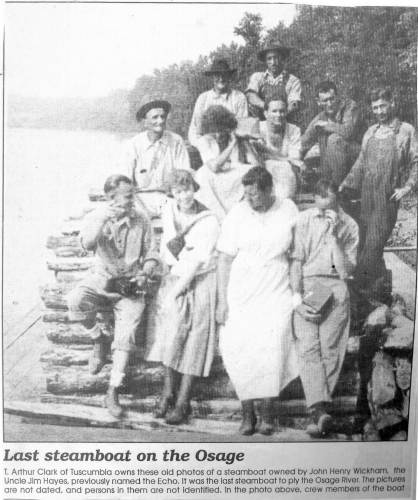
51 Last Steamboat on Osage
Click image for larger view
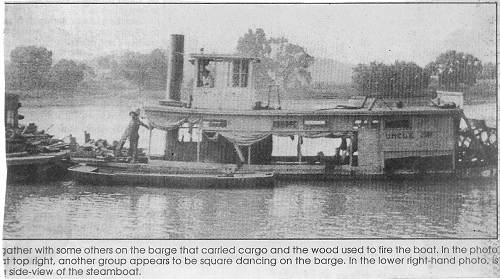
52 Uncle Jim Boat
Click image for larger view
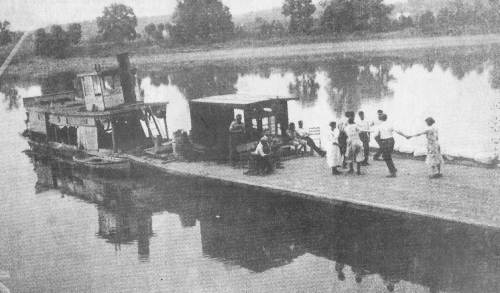
53 Uncle Jim pushing Barge
Click image for larger viewI called Jim Clark, son of Arthur, and he remembers his father talking about the boat as well as the fact that John Halsey Wickham (photo 54) had a riverboat pilot’s license.
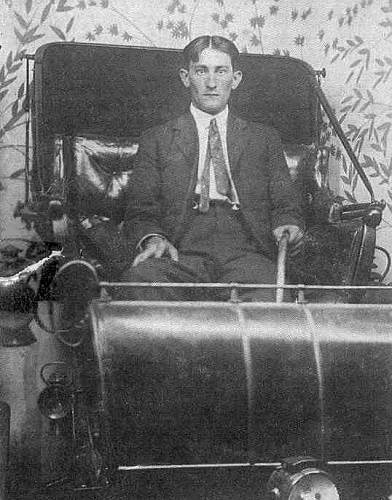
54 John Halsey Wickham I think that John Halsy Wickham would have to be the one in the article named John Henry Wickham because the only John Henry Wickham in the entire Wickham genealogy never came to Miller County.
Although we donít know for sure, I imagine the boat was named after the Jim Hayes who was the Osage City wheat entrepreneur that Arthur Clark mentioned above in his interview with Ginny Duffield.
One of the steamboats which ran the Osage during the 19th century was the “Tuscumbia”. Here is its history taken from our own website.
“The Osage River had one steamer which was built exclusively for carrying the mail from Jefferson City to Tuscumbia. This boat was built by Phil Chappel, then State Treasurer, and others of Jefferson City, as a corporation. The boat was built in 1881 and was christened the “Tuscumbia.” It began carrying the mail in the spring of 1881 as an experiment. The boat was 90 feet long and 18 feet wide and had only one deck; a two-foot gangway extended along the side of the cabin. The mail schedule called for the departure of the boat from Jefferson City at 6 a.m., to arrive at Tuscumbia at 6 p.m., the distance by river being about 75 miles.
In the following year (1882) the Bagnell Branch of the Missouri Pacific was built and the steamer mail was soon discontinued. The company started to build another boat for the Osage River service, but after they completed the hull, which was 130 feet long and 25 feet wide, they decided to use it as a barge, which they did in connection with the “Tuscumbia.” Messrs. Woolery & Loucks of Jefferson City were also interested in this corporation.
The Str. “Tuscumbia” will be remembered by Tuscumbia people as the boat of tragedy as it was from this boat that Mrs. Wm. H. Hauenstein fell into the river one night while she and Mr. Hauenstein were returning from St. Louis and she was drowned. Possibly the last time she was seen alive was by Mr. Sanning who was on the boat coming from Jefferson City. Mr. Sanning was an aged man and he and Mrs. Hauenstein talked for some time after Mr. Hauenstein had retired for the night. According to his version, Mrs. Hauenstein must have fallen from the boat somewhere within 15 miles of Tuscumbia. The body was never recovered although a diligent search was made.”
We don’t have a photo of the steamboat “Tuscumbia” described in the above article which ran the Osage River; however, as an interesting aside, there was another steamboat located in the state of Alabama also named “Tuscumbia” named after the same named town in Alabama. Here is its photo (photo 55) which was found at this website (click on the link):
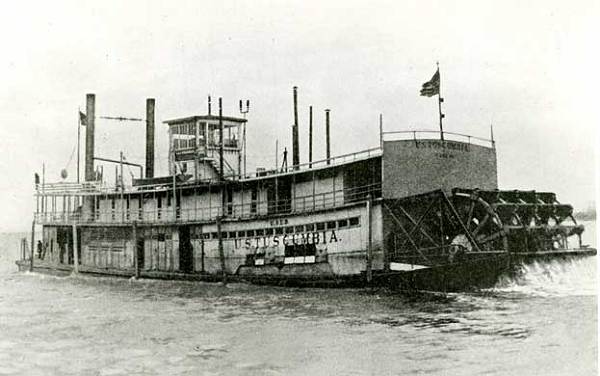
55 Tuscumbia Steamboat
As a followup to last week’s narrative about the Jarrett family, I received this note from Tennyson Jarrett:
Joe
So glad you have the picture of the table in Don & Pam's house. It, like the barber chair, stayed in our garage here from 1968 when we sold the barber shop and came back to San Diego and Sue's cousin, Raymond Graves, took it from our condo in Mesa, Arizona back to Missouri where Pam finished it so beautifully. We decided that the table needed to go "home" so we gave it to our dear Don & Pam. In July, Pam served us the most wonderful meal on it - everything came from the farm except the catfish that Pam's Dad, John Pendleton, caught in his pond. Our daughter, Sharla & husband Israel Van Bramer, Gretta Jarrett Bolien, Don & Pam, Sue & I enjoyed wonderful country cooking. My brother Johannis & I were born in that old house that is falling down - Dad & Mom (John & Edith, Johannis & I) lived there with Grandma Missouri from the time they were married in 1923 until Spring of 1938 when Dad bought the old farmhouse & 120 acres near Mt. View Church of Christ (my mother's brother, Clarence Adams), built the old concrete house, as well as the house where Ralph Hendley lives, the Clemens Kraml house & the Monty & Stephanie Graves house.
|
Thanks Tennyson for the interesting followup!
Alice Henson also wrote me a follow-up about the Jarrett family story last week regarding some information attributed to her which she wanted to correct:
Joe:
In the narrative credited to me it should say that John J. Jarrett (born 1792) married (2) Mrs. Frances Shirley, widow of John, in 1852. Her daughter, Jemima, married John Jarrett's son, David.
|
Perhaps you have had the opportunity in times past to take a walk through some Miller County woods and come upon an old tree which is acutely bent over. I had been told that these trees were bent by Indians as a marker for something important to them. I came across an article about a bent tree which at the time was located on the Earl Thompson farm located on Dry Creek about a mile north from Tuscumbia. The article was written by Autogram reporter Heather Finch who interviewed one of Earl’s daughters, Grace Thompson Dake about the tree:
Indian Water Marker Tree
On Early Thompson Farm
Heather Finch
Miller County Autogram Sentinel
Every now and then we run upon a certain something that reminds us of the past. Grace Thompson Dake is reminded of her childhood when looking at the Indian water marker tree on the Earl Thompson farm in Tuscumbia.
Indian water marker trees were bent by Indians long ago to point towards a spring or other water source. The tree is bent when it is a sapling and then grows into the bend.
“The tree is bent to lead in the direction of water,” said Dake.
“We used to play on the tree when we were little. We would use our imagination and pretend it was a horse,” said Dake.
Beyond the tree, is a spring where she and her siblings would play and bathe when they were children. “We would go and play in the cold water in the summertime after hauling hay and other activities.”
Dake was born and raised in a log cabin in Tuscumbia, but now lives in Eldon. She lived down Dry Creek road where the Indian water marker tree and spring is found. The spring is still there today. It connects to the creek which is often dry.
The spring was the water source for the Thompson family until in the 1940’s when they drilled a well. “The spring hasn’t been used in about 55 years,” explains Dake. “My mother called it the Jubbubbling spring because she thought it made the sound of water poured into a jug.
The Thompsons carried jugs of water from the spring to their home. “Once I was old enough to carry a gallon syrup bucket, I carried water,” explained Dake.
Dake remembered a special place where she and her family would wade in the summertime. “There was this pool made of limestone that looked like a bathtub in the creek where we would bathe and swim. The water was always clean because of the constant movement of the creek. Mosses, ferns, rocks and flowers surrounded the pool. “It’s beautifull by the spring,” said Dake.
Dake loves nature. She collects a variety of rocks. She had fossils that are a couple of million years old. She also had a wide variety of arrowheads.
Besides collecting items valuable to her, she creates them. Dake creates jeweled violins, butterflies, doves, and many other pictures.
The violin she displays in her living room took a year to create. It remains in a glass case where it can be viewed rotating under a black light. One of the violins she made she sold to David Alan Coe. She starts anything she creates by covering it with dark green glitter to make it standout, sparkle and glow in a black light. Then she adds the larger jewels. The smaller jewels follow the ones larger in size. The product is finished after a lot of dedication.
Here are the photos which accompanied the article (photos 56 and 57):
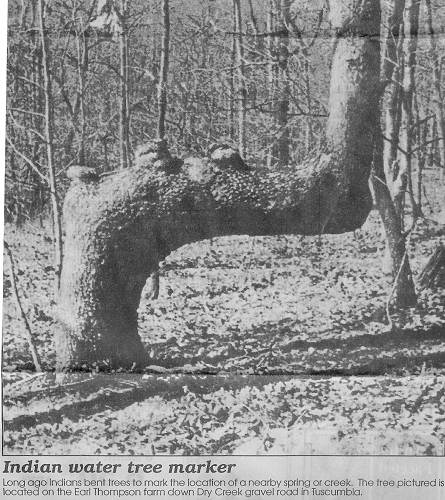
56 Bent Tree
Click image for larger view
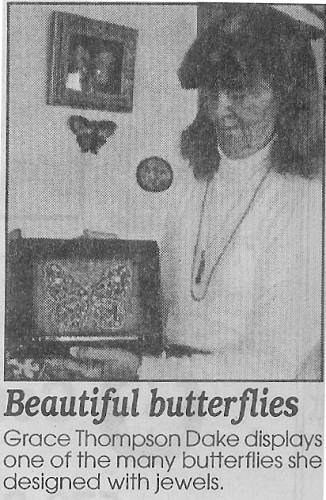
57 Grace Thompson Dake Grace’s father, Earl Thompson, was one of our county’s very interesting personalities. I wrote about him in a previous Progress Notes.
Earl’s life was so interesting that I highly recommend you take the time to read it sometime at the link above.
You can read more about bent tree markers at this website (click on the link).
After reading the article about the bent tree on the Earl Thompson farm it occurred to me that more than likely the tree is still there so I called Wanda Wright, one of our museum board members, whose son Tom Wright, now is the owner of the farm where is located the bent tree discussed in the article above. She got in touch with Tom who invited me over to see the tree. Tom took me in his truck part way up a valley which had a large enough spring to keep a pond full all year. Just a short distance up the valley from the pond was the bent tree. Here are some photos of the tree and Tom (photos 58 and 59).
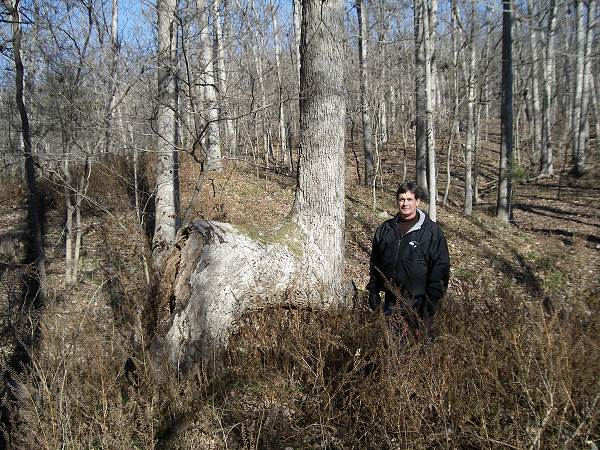
58 Bent Tree and Tom Wright
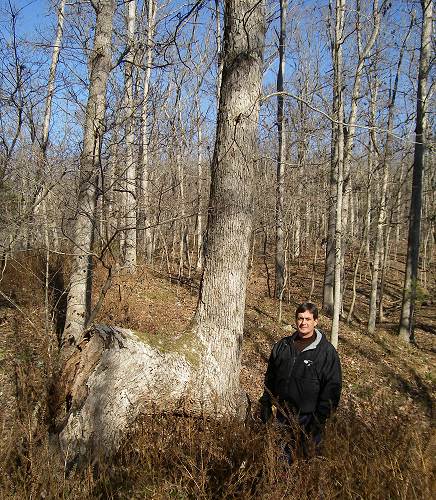
59 Bent Tree and Tom Wright The horizontal part of the tree is pointing directly to the location of the spring and pond just a few steps down the valley. Since the tree would have to have been a pliable sapling when it was bent, the size of the bent trunk now would suggest it is very old.
As an interesting side trip, Tom took me on a hike to hill side nearby where some geologically very old stones and boulders are located; probably the result of some type of intraterraneal upheaval long ago (photos 60 and 61).
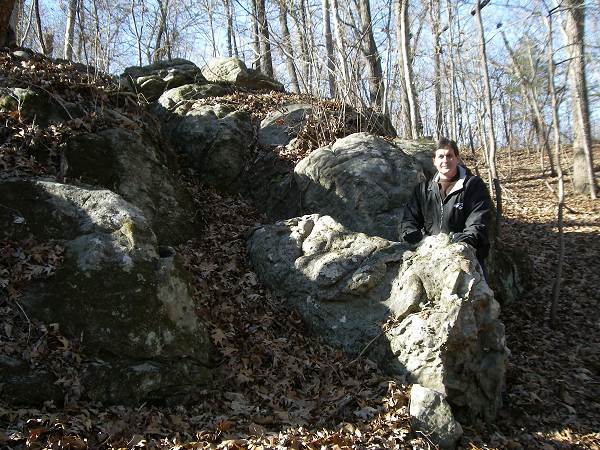
60 Rock Upheaval
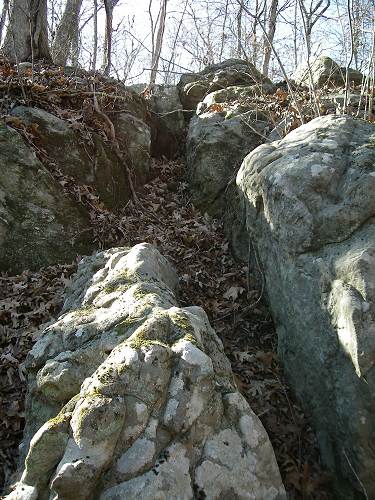
61 Rock Crevice
I joined Dan Peek and many others at three of his book signing events last week. These events were so popular that all the copies of his book, “Live! At The Ozark Opry,” were sold out at the three events (photos 62 and 63).
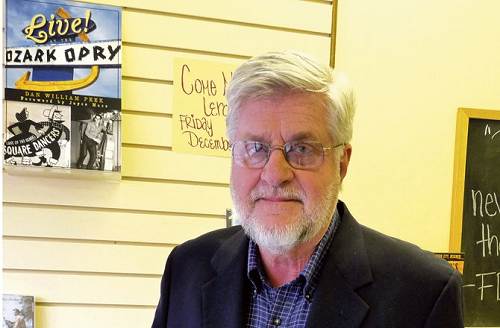
62 Daniel Peek
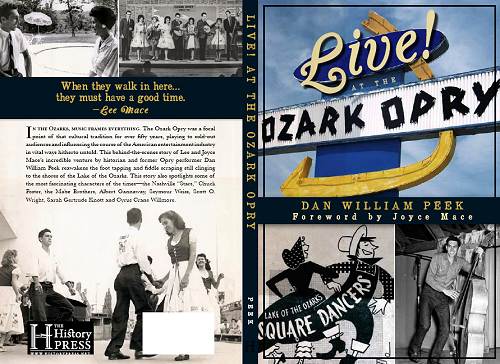
63 Ozark Opry Live Book Cover
Click image for larger view (in PDF format)Two of the book signings were sponsored by the Downtown Book and Toy Store on High Street in Jefferson City and the third was at Stonecrest Mall in Osage Beach. Dan’s book is a wonderfully written history of Lee Mace’s Ozark Opry show which ran continuously for more than fifty years at Osage Beach. The show would be running even now but finally had to close its doors in 2005 because the new Highway 54 road construction took most of the parking space in front of the Opry auditorium. You can read a very well written story about Dan and the Ozark Opry history in Osage Beach (click on the link).
For convenience I will copy that article here as an attachment (photo 64).
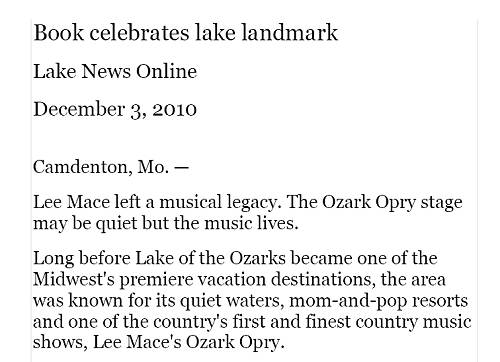
64 Book Celebrates Lake Landmark Article
Click image to read entire article in PDF formatI took several photos of the events and the people who attended the book signing both at the Downtown Book and Toy Store as well as Stonecrest Mall. I will present the photos as a collage with captions in which you will recognize several of the former Opry performers as well as Joyce Mace, wife of Lee Mace, who herself was instrumental in the success of the Opry (photos 65 - 84):
Hold your mouse cursor over a photo to read the caption and click on any of the thumbnails to view a larger image.
Note: Once you click on an image below, a new window will open. It would be best to maximize this new window by clicking on the middle box in the upper right-hand corner of the window. When you move your cursor over the image in this new window, it will change to a magnifying glass. Once this occurs, click on the image and it will show in a larger format for easier viewing.
I had the opportunity to meet a number of people who through the many years had enjoyed watching the Ozark Opry on Jefferson City’s KRCG TV which produced a weekly live show of Lee and the Opry performers for many years beginning in 1956. Local TV KRCG announcer Kermit Miller came to the Downtown Book and Toy Store to make a video which he ran on his newscast last week (photos 85 and 86).
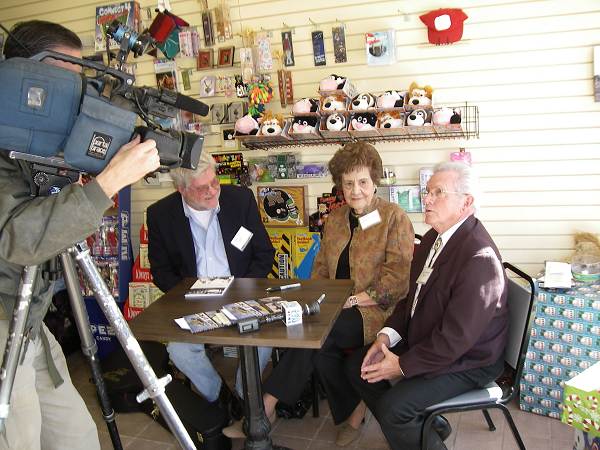
85 Kermit Miller interviewing Bill Goofer Atterberry, Joyce Mace and Dan Peek
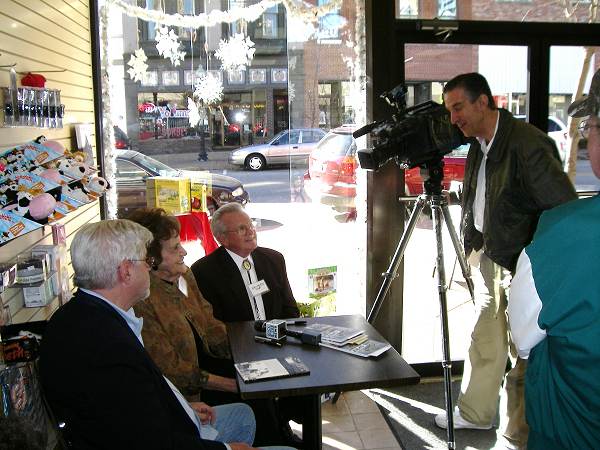
86 Kermit Miller of KRCG interviewing Bill Goofer Atterberry, Joyce Mace and Dan Peek At the Stonecrest Mall booksigning, radio station 102.9 interviewed Dan Peek live on the air (photos 87 and 88):
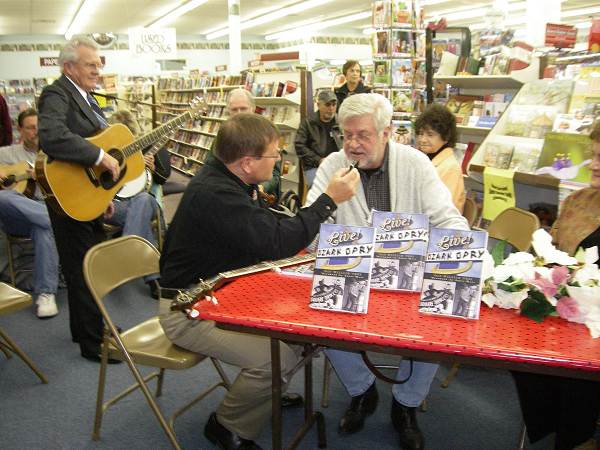
87 Radio Station 102.9 Interview with Dan Peek
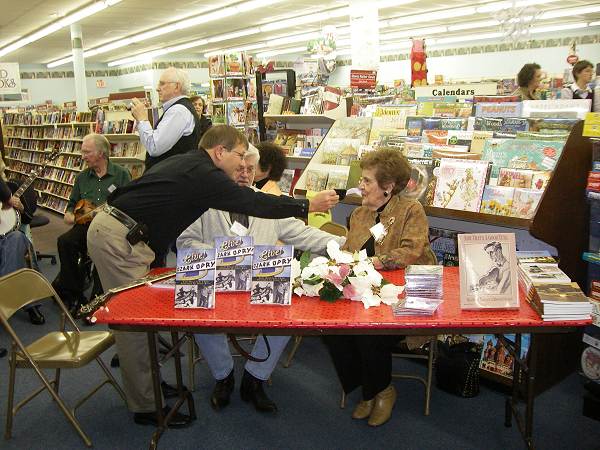
88 Radio Station 102.9 Interview with Joyce Mace One interesting person I met at the Downtown Book and Toy Store was Associate Circuit Court Judge Peggy Richardson of Moniteau County. Peggy said she had participated in the Opry’s 1977 annual talent show, a photo of which she had with her (photos 90 and 91).
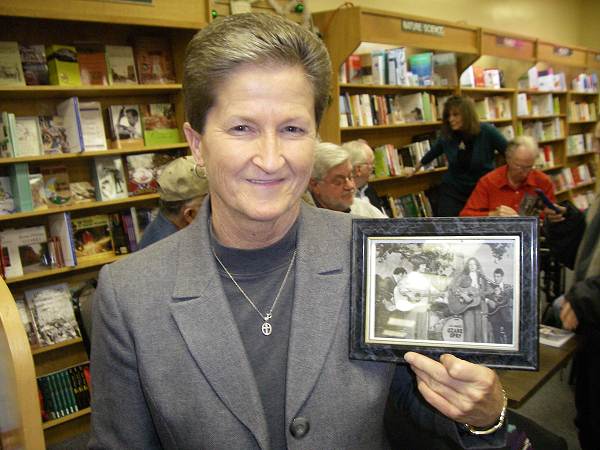
90 Peggy Richardson Associate Circuit Judge Moniteau County
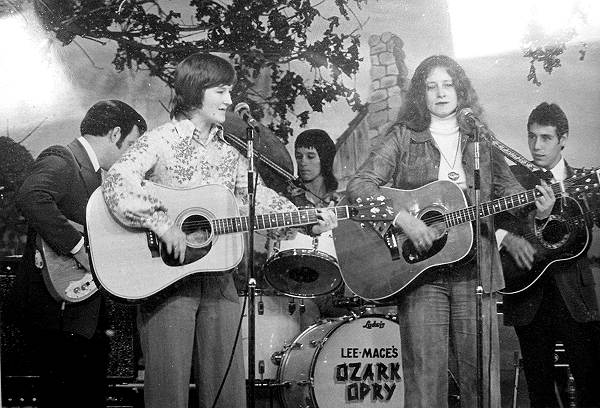
91 Peggy and friend performing at 1977 Opry Talent Show Bill “Goofer” Atterberry was delighted to have his photo taken with Peggy (photo 92).
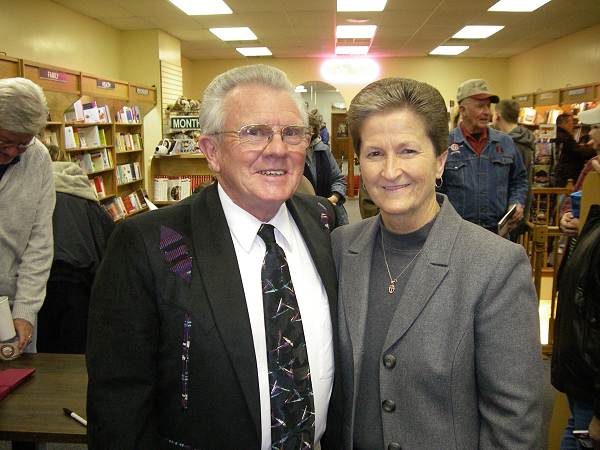
92 Bill Goofer Atterberry and Peggy Richardson At Stonecrest Mall I met William and Dorothy Williams, the parents of Joy Williams Peek, wife of Dan Peek (photo 93).
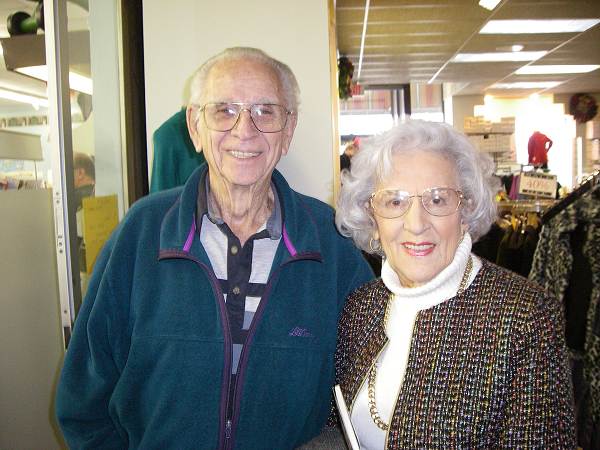
93 William and Dorothy Williams They are natives of Versailles and have devoted the last few years to an inventory of all of Morgan County’s cemeteries. So far, they have surveyed 150 Camden county cemeteries and recorded more than 27,500 burials. They have published a four volume set of books with the names and location of the burials in Morgan County. If you are interested in genealogy of Morgan and surrounding counties this type of information is invaluable. Here is their personal card for inquiries (photo 94):
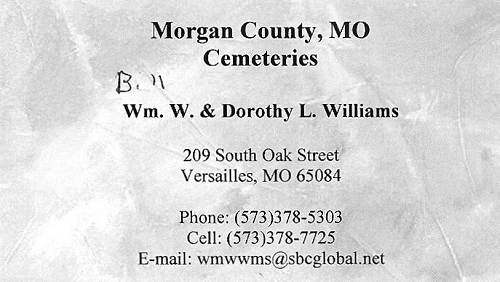
94 William and Dorothy Willams - Cemetery Audits
For more Ozark Opry history as well as many photos from some of the old Ozark Opry programs sold each year don’t fail to visit the official Ozark Opry website (click on the link).
The official Ozark Opry website also links to previous Progress Notes I wrote about Lee Mace, his family and the Ozark Opry.
That’s all for this week.
 Joe Pryor
Previous article links are in a dropdown menu at the top of all of the pages.
|

